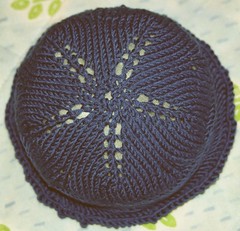For those who’ve heard me talk about baking bread and don’t really want to “wing it,” here’s what I basically end up doing when I bake “sandwich” bread, or non-savory bread. If you want a savory bread, you’re looking for the recipe at Barley Boules, which can also have olives added to it & give you olive bread. The recipe below is for people who shy away from true Whole Wheat bread; if you want (and I do), you can simply swap Whole Wheat for the White flour & you’ll be OK.
Basic Everyday Bread:
- 4C water
- 2C whole wheat flour
- 2C white flour
- 1C Quinoa flour (optional, but recommended)
- 2C Flax Seeds (I use golden, but it doesn’t matter except in appearance: dark seeds make mottled looking bread)
- 1/2C Oat Bran
- 1/4C Wheat Germ
- 1C Molasses
- 1/2C Honey
- 1 Tbsp sugar
- 2 Tbsp Yeast (not the rapid-rise junk!)
- 1 Tbsp salt
- Proof yeast in bottled / filtered water (bring water to 105-110 deg. F, add sugar, add yeast, wait 10 min’s for it to “bloom”).
- Add whole wheat flour (and Quinoa flour, if you’ve got it) to water & cover with plastic wrap (I put a heating pad on low underneath the bowl if the house is cool). Let this rise until tripled in size.
- Add honey and molasses and mix in white flour until you have a very moist dough-ball (don’t add too much!). Let this rise until doubled in size.
- Add the dough ball & then set the mixer to knead the dough. Let it knead until you’ve got the consitency of chewing gum – don’t worry, you could go for about 15 minutes and not overknead. I’ve had the Kitchenaid overheat ’cause I let it go so long, and it was just fine.
- Add all the seeds, bran, wheat germ, and the salt (don’t forget that, whatever you do, ’cause it controls the yeast growth) to your Kitchenaid’s mixing bowl along with a little bit of white flour, and let it knead at least until all of the seeds have been incorporated. Keep adding little bits of white flour to keep the dough from sticking to the sides, as needed.
- Dump out onto a floured surface and let rest for a bit; divide into 4 loaves; shape and place into oiled loaf pans; spray tops with olive oil; cover with plastic and let them rise until they’ve almost doubled in size. (You can tell that they’ve risen enough if, when you poke them gently, the dimple doesn’t really want to spring back)
- Place into a 350 deg. F oven & bake until interior temperature (probe thermometer, here) is 190 deg. F. You can go a bit darker or a bit lighter than 190, but not more than 5 degrees lighter or you’ll have raw dough.
- Let cool in their pans for about 10 minutes, so they “sweat” and release from the pans.
- Cool on racks, covered with a tea-towel, overnight & they’ll be easier to slice.










